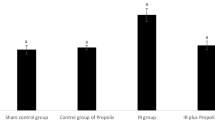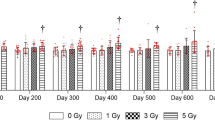Abstract
IT has been shown that the shielding of the liver in situ protects 73 per cent of a group of rats against a dose of X-rays which is 100 per cent lethal after fifteen days for the control animals1. E. S. G. Barron2 showed that glutathione had a protective action in mice when injected before the lethal irradiation. Bacq and his co-workers3 have shown that β-mercaptoethylamine protects mice against a lethal dose of X-rays when this compound is injected into the animals immediately before the total body irradiation. We have been able to confirm these results in rats4. On the other hand, the β-mercaptoethylamine is completely inactive when given even immediately after the exposure to a lethal dose.
This is a preview of subscription content, access via your institution
Access options
Subscribe to this journal
Receive 51 print issues and online access
$199.00 per year
only $3.90 per issue
Buy this article
- Purchase on SpringerLink
- Instant access to full article PDF
Prices may be subject to local taxes which are calculated during checkout
Similar content being viewed by others
References
Mandart, M., Lambert, G., Maisin, H., and Maisin, J., C.R. Soc. Biol., 146, 1647 (1952).
Barron, E. S. G., Manhattan District Declassified Document 484. (Oak Ridge: Atomic Energy Commission, Technical and Information Division, 1946.)
Bacq, Z. M., and Herve, A., Bull. Acad. R. Med. Belg., 17, 19 (1952).
Lambert, G., Maisin, J., and Mandart, M., C.R. Soc. Biol., 146, 1434 (1952).
Author information
Authors and Affiliations
Rights and permissions
About this article
Cite this article
MAISIN, J., LAMBERT, G., MANDART, M. et al. Therapeutic Action of Glutathione and Mercaptoethylamine against a Lethal Dose of X-Rays. Nature 171, 971 (1953). https://doi.org/10.1038/171971a0
Issue Date:
DOI: https://doi.org/10.1038/171971a0



